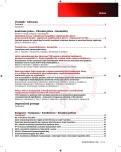Introduction of the treatment with recombinant FVIII has not increased the inhibitor incidence rate in Czech PUPs with haemophilia A
Authors:
J. Blatný 1; V. Komrska 2; B. Blažek 3; Ovesná P Jménem 4; Pro Centra Českého Národního Hemofilického Programu (čnhp)
Authors‘ workplace:
Oddělení dětské hematologie, FN Brno
1; Klinika dětské hematologie a onkologie, FN Motol, Praha
2; Dětská klinika, FN Ostrava
3; Institut biostatistiky a analýz MU, Brno
4
Published in:
Transfuze Hematol. dnes,20, 2014, No. 1, p. 19-24.
Category:
Comprehensive Reports, Original Papers, Case Reports
Overview
Both relative and absolute incidence of inhibitors against FVIII in previously untreated patients (PUPs) receiving only rFVIII in the Czech Republic between 2003 and 2012 were evaluated based on the Czech National Haemophilia Programme (CNHP) registry data. These findings were correlated with the treatment regimens used and relevant relationships were investigated. Incidence of inhibitors against FVIII in PUPS treated with rFVIII and pdFVIII was compared as well. From 2003–2012, 41 PUPs were treated for 118 treatment years with rFVIII in the Czech Republic. None of the children with mild/moderate haemophilia A developed inhibitors. Relative incidence of inhibitors in PUPS was 5.2 per 100 treatment years (5,2%) in rFVIII treated and 4,7 per 100 treatment years (4,7%) in pdFVIII treated PUPs . All of these PUPS were children with severe haemophilia A. Relative incidence of inhibitors in PUPs thus did not differ significantly between the groups treated with rFVIII and with pdFVIII. Absolute incidence of inhibitors was 20% for rFVIIa and 26% for pdFVIII. This difference was not statistically significant either. We thus conclude that the incidence of inhibitors in Czech PUPs is low and introduction of rFVIII in 2003 has not led an increase in inhibitor development risk in our country to date.
Key words:
haemophilia, incidence, inhibitors, recombinant factor concentrate
Sources
1. Blanchette VS, Manco-Johnson M, Santagostino E, Ljung R. Optimizing factor prophylaxis for the haemophilia population: where do we stand? Haemophilia 2004; 10(Suppl 4): 97-104.
2. Smejkal P, Blatný J, Blažek B, et al. Diagnostika a léčba hemofilie. Transfuze Hematol dnes 2013; 19: 100-114.
3. Manco-Johnson MJ, Blanchette VS. North American prophylaxis studies for persons with severe haemophilia: background, rationale and design. Haemophilia 2003; 9(Suppl 1): 44-49.
4. Auerswald G, Bidlingmaier C, Kurnik K. Early prophylaxis/FVIII tolerization regimen that avoids immunological danger signals is still effective in minimizing FVIII inhibitor developments in previously untreated patients – long-term follow-up and continuing experience. Haemophilia 2012; 18: e18-e20.
5. Gouw SC, van der Bom JG, Ljung R, et al. Factor VIII products and inhibitor development in severe hemophilia A. N Engl J Med 2013; 368: 231-239.
6. Taki M, Hanabusa H, Fukutake F, et al. Clinical experience of previously untreated patients (PUPs) with antihemophilic factor (recombinant), plasma/albumin-free method from post-authorization safety surveillance in Japan: 5-year update. XXX. International Congress of the World Federation of Hemophilia, July 8-12, 2012, Paris, France. Abstract no. PO-WE-066.
7. Auerswald G, Thompson AA, Recht M, et al. Experience of Advate rAHF-PFM in previously untreated patients and minimally treated patients with haemophilia A. Thromb Haemost 2012; 107: 1072-1082.
8. Hay CR, Palmer B, Chalmers E, et al. Incidence of factor VIII inhibitors throughout life in severe hemophilia A in the United Kingdom. Blood 2011; 117: 6367-6370.
9. Kurnik K, Auerswald G, Kreuz W. Inhibitors and prophylaxis in paediatric haemophilia patients: Focus on the German experience. Thromb Res 2013; publikováno elektronicky 17. listopadu 2013. DOI 10.1016/j.thromres.2013.10.017
10. Gouw SC, van der Bom JG, van den Berg HM. Treatment-related risk factors of inhibitor development in previously untreated patients with hemophilia A: the CANAL cohort study. Blood 2007; 109: 4648-4654.
11. Manco-Johnson MJ, Abshire TC, Shapiro AD, et al. Prophylaxis versus episodic treatment to prevent joint disease in boys with severe hemophilia. N Engl J Med 2007; 357: 535-544.
12. Gringeri A, Lundin B, von Mackensen S, et al. A randomized clinical trial of prophylaxis in children with hemophilia A (the ESPRIT Study). J Thromb Haemost 2011; 9: 700-710.
13. Reininger AJ, Chehadeh HE. The principles of PK-tailored prophylaxis. Hamostaseologie 2013; 33(Suppl 1): S32-S35.
14. Barnes C. Importance of pharmacokinetics in the management of hemophilia. Pediatr Blood Cancer 2013; 60(Suppl 1): S27-S29.
Labels
Haematology Internal medicine Clinical oncologyArticle was published in
Transfusion and Haematology Today

2014 Issue 1
Most read in this issue
- Toxoplasma and immunodeficiency
- TP53 deletion in patients with multiple myeloma and monoclonal gammopathy of undetermined significance - molecular cytogenetic analysis of 84 patients
- Are we justified to classify patients with two unrelated clones with del(5q) and trisomy 8 as a subgroup of myelodysplastic syndrome of the type of 5q- syndrome?
- Optimal process for searching for adult unrelated volunteer donors in unrelated donor registries
